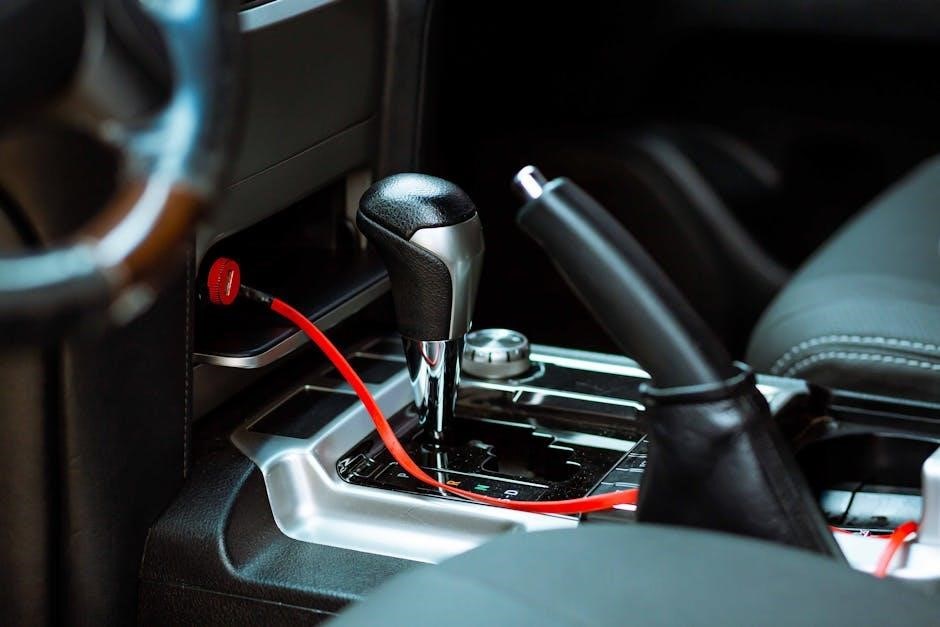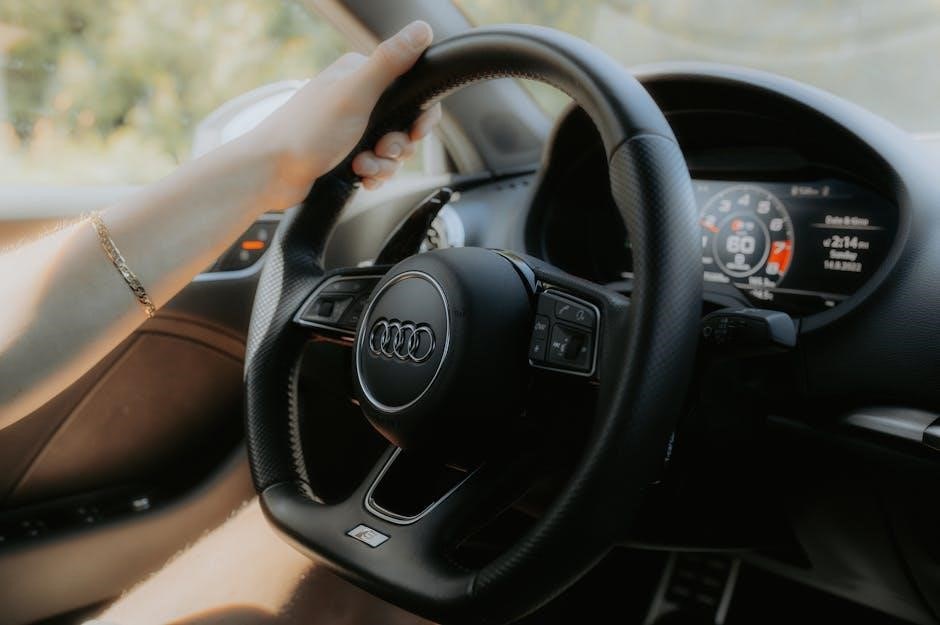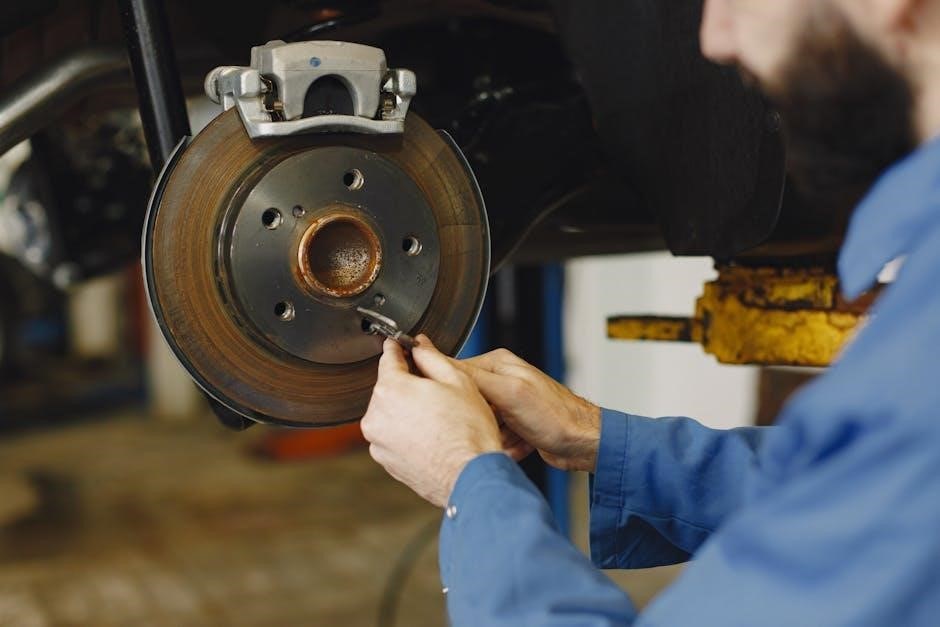Manual brakes are a mechanical system providing direct control over braking force‚ offering simplicity‚ reliability‚ and precision. They are favored for their linear response and driver feedback.
1.1 Definition and Purpose of Manual Brakes
Manual brakes are a mechanical system that relies on direct driver input to apply braking force without power assistance. Unlike power brakes‚ manual systems use a pedal connected to a master cylinder‚ which distributes hydraulic pressure to the calipers or brake shoes. Their primary purpose is to provide reliable and consistent braking performance‚ especially in high-performance or racing applications where precise control is critical. Manual brakes eliminate the complexity of vacuum boosters and servos‚ offering a simpler‚ lighter‚ and more driver-connected experience. They are favored for their ability to deliver immediate feedback and linear modulation‚ making them ideal for drivers seeking maximum control over their vehicle’s deceleration.
1.2 History and Evolution of Manual Brake Systems
Manual brake systems have evolved significantly since their inception in early automotive history. Initially‚ manual brakes relied on mechanical linkages and cables to apply braking force directly to the wheels. Over time‚ hydraulic systems replaced these mechanical connections‚ offering improved efficiency and consistency. The introduction of master cylinders and calipers in the mid-20th century marked a significant advancement. Modern manual brakes now feature optimized pedal ratios‚ adjustable pushrods‚ and high-performance pad compounds‚ enhancing both control and stopping power. Their enduring popularity in racing and high-performance vehicles underscores their effectiveness and reliability‚ making them a preferred choice for drivers seeking precise braking control and minimal complexity.

Key Components of a Manual Brake System
Manual brake systems consist of a brake pedal‚ master cylinder‚ calipers‚ pads‚ pushrod‚ and adjustment mechanisms‚ ensuring precise control over braking force and vehicle stopping performance.
2.1 Brake Pedal and Pedal Ratio
The brake pedal serves as the primary input for manual braking systems. Its design and pedal ratio significantly influence the braking performance. The pedal ratio refers to the distance from the pivot point to where the foot applies pressure‚ compared to the distance from the pivot to the master cylinder pushrod connection. A higher pedal ratio amplifies the force applied‚ reducing the effort needed to actuate the brakes. For example‚ a 6:1 ratio means the pedal travels six units for every unit of pushrod movement. Proper pedal ratio setup ensures optimal leverage‚ making braking more efficient and responsive‚ especially in high-performance applications where precise control is crucial.
2.2 Master Cylinder and Bore Size
The master cylinder is the heart of a manual brake system‚ converting pedal pressure into hydraulic pressure to actuate the brakes. Its bore size is critical‚ as it determines the volume of brake fluid displaced. A larger bore size increases fluid volume‚ which can enhance braking force but may require more pedal effort. Proper sizing ensures optimal performance‚ balancing responsiveness and control. For example‚ a 1.032-inch bore master cylinder is commonly used in high-performance applications like the TBM 1993-02 Camaro/Firebird kit. Matching the master cylinder bore with the pedal ratio and caliper setup is essential for achieving precise‚ linear braking performance‚ especially in racing or heavy vehicles where consistent control is vital.

2.3 Brake Calipers and Pad Compound
Brake calipers play a crucial role in manual brake systems by housing the pistons that apply pressure to the brake pads. The caliper design‚ whether fixed or floating‚ impacts braking efficiency and heat dissipation. The pad compound is equally important‚ as it determines friction levels and heat tolerance. Common compounds include metallic‚ ceramic‚ and carbon-based materials‚ each suited for different driving conditions; For racing‚ high-friction compounds are preferred for their consistent bite and thermal stability. Proper pad selection ensures optimal stopping power and pedal feel‚ while incorrect choices can lead to reduced performance or excessive wear. Matching calipers and pads is vital for achieving precise‚ reliable braking in manual systems.
2.4 Pushrod and Adjustment Mechanisms
The pushrod is essential for transferring motion from the master cylinder to the brake calipers‚ ensuring consistent and precise braking. Proper alignment and length are critical to avoid preload‚ which can lead to spongy pedals or uneven braking. Adjustment mechanisms‚ such as threaded rods or clevis pins‚ allow fine-tuning of the pushrod length to maintain optimal system performance. These mechanisms are often paired with master cylinder placement to ensure the pushrod operates smoothly without binding. Regular maintenance of these components is necessary to prevent issues like excessive play or misalignment‚ which can compromise braking efficiency and safety in manual systems.

Benefits of Manual Brakes Over Power Brakes
Manual brakes offer superior control‚ feedback‚ and simplicity‚ with no reliance on power assistance. They reduce weight and complexity‚ making them ideal for racing and high-performance applications.
3.1 Weight Reduction and Simplicity
Manual brakes eliminate the need for heavy power-assisted components‚ significantly reducing overall vehicle weight. Without bulky servos or complex wiring‚ they offer a straightforward‚ lightweight solution. This simplicity enhances reliability and reduces potential failure points‚ making manual brakes a preferred choice for racing and performance vehicles. less components also improve under-hood space and lower production costs. With fewer moving parts‚ manual systems require less maintenance‚ appealing to enthusiasts seeking a no-frills‚ high-performance setup. The lightweight design contributes to better handling and braking efficiency‚ providing a direct‚ unassisted connection between driver input and braking force.
3.2 Improved Control and Feedback
Manual brakes provide enhanced control and feedback‚ allowing drivers to precisely modulate braking force. The direct mechanical connection between the pedal and calipers eliminates power-assisted lag‚ offering a more tactile driving experience. This responsiveness is particularly advantageous in racing and performance driving‚ where subtle brake inputs can make a significant difference. The absence of electronic or hydraulic assistance enables drivers to feel the braking force directly‚ improving modulation and preventing wheel lock-up. This level of control fosters confidence and precision‚ making manual brakes a preferred choice for enthusiasts and professionals seeking optimal braking performance in high-demand scenarios.
3.4 Linear Braking Performance
Manual brakes deliver consistent‚ linear braking performance‚ free from the variability of power-assisted systems. The direct mechanical linkage ensures that pedal input translates proportionally to brake force‚ eliminating the non-linear feel of boosted brakes. This predictability allows drivers to consistently apply the correct pressure‚ enhancing stopping precision. The absence of boosters also reduces system complexity‚ minimizing potential failure points. For racing and high-performance applications‚ linear braking performance is critical‚ as it enables precise control over deceleration rates. This consistency is a key advantage of manual brakes‚ making them a reliable choice for drivers seeking dependable and repeatable braking behavior in demanding conditions.

Manual Brake Conversion Kits
Manual brake conversion kits reduce weight and enhance braking performance‚ offering a simpler‚ high-performance solution. Popular kits include BMR Suspension and Motion Raceworks‚ compatible with F-Body‚ S10‚ and GM models.
4.1 Popular Conversion Kits for F-Body‚ S10‚ and GM Models
These kits are designed to optimize performance and simplicity. BMR Suspension offers a Manual Brake Conversion Kit for F-Body models‚ enhancing braking capabilities and reducing weight. Motion Raceworks provides billet aluminum master cylinders for S10 and GM vehicles‚ ensuring durability and precise control. These kits are ideal for high-performance applications‚ offering improved modulation and feedback. They are compatible with various vehicle platforms‚ making them a preferred choice among racers and enthusiasts. Each kit is engineered to deliver consistent braking performance‚ ensuring safety and reliability under demanding conditions.
4.2 Motion Raceworks Billet Aluminum Master Cylinder Kits
Motion Raceworks offers premium billet aluminum master cylinder kits designed for manual brake conversions. These kits are compatible with 1994-04 S10/Sonoma and 1979-93 Fox Body models‚ ensuring precise control and durability. Priced at $229.99‚ with a discounted option of $189.99‚ they are a cost-effective upgrade. The aluminum construction reduces weight while maintaining strength‚ enhancing braking performance. These kits are ideal for enthusiasts seeking a reliable‚ high-quality manual braking system‚ delivering consistent results in high-performance applications.
4.3 BMR Suspension Manual Brake Conversion Kit
BMR Suspension’s manual brake conversion kit is designed for 1993-2002 F-Body models‚ offering a lightweight and high-performance solution. This kit reduces weight and enhances under-hood space while improving braking efficiency. It features a 6:1 or 7:1 pedal ratio‚ ensuring optimal leverage for the master cylinder‚ allowing precise control and consistent braking performance. Ideal for street and race applications‚ this kit delivers enhanced braking capabilities without compromising simplicity. Its robust design ensures reliability‚ making it a popular choice among enthusiasts seeking to upgrade their braking systems for better responsiveness and control.

Setting Up a Manual Brake System
Setting up a manual brake system involves precise pedal ratio and master cylinder alignment‚ ensuring optimal braking performance without excessive pedal effort or system lag.
5.1 Pedal Ratio and Master Cylinder Bore Matching
Pedal ratio and master cylinder bore matching are critical for optimal braking performance. A higher pedal ratio (e.g.‚ 6:1 or 7:1) provides greater leverage‚ reducing pedal effort while maintaining control. The master cylinder bore size must align with the pedal ratio to ensure proper fluid displacement and consistent braking force. Misalignment can lead to poor modulation or excessive pedal pressure‚ especially in heavier vehicles. Proper matching ensures linear braking response‚ making it easier to control deceleration smoothly. This setup is particularly important for racing applications‚ where precise control and consistent performance are essential for safety and competitiveness.
5.2 Front-to-Rear Brake Bias Adjustment
Front-to-rear brake bias adjustment ensures balanced braking performance by distributing stopping force between the front and rear wheels. Proper adjustment prevents wheel lockup and maintains vehicle stability. In manual brake systems‚ this is achieved by adjusting the brake proportioning valve or master cylinder setup. The ideal bias depends on vehicle weight distribution‚ suspension geometry‚ and driving conditions. For racing applications‚ a slightly rear-biased setup can improve corner entry control‚ while a front-biased setup enhances straight-line braking. Correct adjustment is critical for maximizing grip‚ minimizing stopping distances‚ and maintaining driver control. It requires careful tuning to match the vehicle’s dynamics and intended use.
5.3 Ensuring Proper Pushrod Alignment
Proper pushrod alignment is crucial for smooth manual brake operation. Misalignment can cause uneven braking‚ reduced control‚ or even system failure. The pushrod must be precisely aligned with the master cylinder and pedal assembly to ensure consistent actuation. Adjustments should be made to eliminate any preload or binding‚ ensuring the pushrod moves freely. Regular inspection and fine-tuning are necessary to maintain optimal performance. Improper alignment can lead to increased pedal effort and reduced braking efficiency. Always refer to the manufacturer’s specifications or consult a professional for complex adjustments to guarantee reliability and safety in your manual brake system.

Manual Brakes in Racing Applications
Manual brakes are favored in racing for their precision and consistent feel‚ allowing drivers to modulate braking force effectively‚ enhancing control during high-speed maneuvers.
6.1 Advantages of Manual Brakes for Racing
Manual brakes offer superior control and feedback‚ crucial for precise lap times. They eliminate power assist lag‚ providing direct modulation and consistent braking performance. Racers prefer their linear response‚ which allows exact brake force application. Unlike power brakes‚ manual systems avoid unnecessary weight and complexity‚ enhancing vehicle agility. Additionally‚ they ensure reliability under extreme conditions‚ as there’s no reliance on vacuum or electrical systems. This makes them ideal for high-performance racing environments where driver feel and immediate response are critical for competitive advantage and safety. Their simplicity also reduces potential failure points‚ ensuring consistent braking throughout races.
6.2 Optimizing Brake Systems for High-Performance Vehicles
Optimizing manual brake systems for high-performance vehicles involves precise tuning of key components. Pedal ratio and master cylinder bore size must be matched to ensure optimal leverage and hydraulic pressure. High-friction pad compounds enhance stopping power‚ while proper front-to-rear brake bias ensures balanced weight distribution during deceleration. Adjusting these elements minimizes brake fade and maximizes control‚ critical for racing. Additionally‚ lightweight materials and efficient cooling systems are integrated to manage heat and maintain consistent performance. Proper alignment of the pushrod and master cylinder ensures smooth actuation‚ avoiding unnecessary resistance. These optimizations ensure manual brakes deliver reliable‚ predictable stopping power‚ essential for competitive racing environments.

Maintenance and Troubleshooting
Regular maintenance ensures manual brakes function optimally. Inspect for worn pads‚ fluid leaks‚ or misaligned components. Bleeding the system removes air‚ preventing spongy pedals. Adjust pushrod alignment and ensure proper brake bias for consistent performance. Addressing issues promptly avoids failure and maintains safety.
- Check brake fluid levels and condition regularly.
- Inspect pads and rotors for wear or damage.
- Ensure pushrod alignment and proper bleeding techniques.
7.1 Common Issues with Manual Brake Systems
Manual brake systems are generally reliable but can experience specific issues. Air in the brake lines often causes a spongy pedal‚ reducing responsiveness. Misaligned pushrods and incorrect pedal ratios lead to inconsistent braking performance. Worn brake pads or rotors can cause noise and decreased stopping power. Additionally‚ improper bleeding techniques may result in uneven brake distribution‚ affecting overall control. Over time‚ components like seals in the master cylinder can degrade‚ leading to fluid leaks. Regular maintenance‚ such as bleeding the system and inspecting pads‚ helps prevent these issues. Addressing problems early ensures optimal braking efficiency and safety.
7.2 Adjusting and Bleeding the Brake System
Adjusting and bleeding the brake system ensures optimal performance and safety. Start by aligning the pushrod with the master cylinder‚ ensuring no preload. Use a wrench to adjust the pushrod length for proper alignment. Bleeding the system removes air bubbles‚ guaranteeing fluid flows freely. Use the correct brake fluid and a clean environment to avoid contamination. Pump the pedal firmly to push fluid through the lines‚ then bleed each caliper starting from the farthest wheel. Check the pedal feel after bleeding; it should be firm. Repeat if necessary. Proper adjustment and bleeding ensure consistent braking power and even distribution‚ critical for driver control and safety.

Manual Brake Systems in Modern Vehicles
Modern vehicles integrate manual brakes with advanced systems‚ including electronic parking brakes (EPB) and compatibility with cutting-edge brake technologies‚ ensuring reliability and seamless performance in contemporary automotive designs.
8.1 Electronic Parking Brake (EPB) Integration
Modern manual brake systems often incorporate Electronic Parking Brake (EPB) technology‚ enhancing convenience and safety. EPB systems electronically activate rear brakes when the vehicle is stationary‚ eliminating the need for manual levers. This integration ensures compatibility with advanced vehicle electronics while maintaining the simplicity and direct control of manual brakes. EPB systems are particularly advantageous in modern vehicles‚ as they reduce mechanical complexity and improve reliability. The seamless combination of manual braking with electronic parking functionality offers drivers both precision and ease of use‚ making it a popular choice in contemporary automotive designs.
8.2 Compatibility with Advanced Brake Technologies
Manual brake systems are increasingly compatible with advanced brake technologies‚ offering enhanced performance and integration. Modern setups can incorporate features like ABS‚ ESC‚ and even hybrid systems‚ ensuring safety and efficiency. CNC-machined components and magnetic brake systems are now being integrated with manual brakes‚ providing precise control and reliability. These advancements allow manual brakes to coexist with sophisticated vehicle electronics‚ maintaining their simplicity while benefiting from cutting-edge innovations. This compatibility makes manual brakes a viable option for drivers seeking a balance between traditional control and modern technological advancements‚ ensuring optimal braking performance in various driving conditions.

Future Trends in Manual Brake Technology
Future trends include CNC-machined components and magnetic brake systems‚ offering improved precision and reliability. These innovations enhance braking performance while maintaining simplicity and driver control.
9.1 Integration of CNC and Magnetic Brake Systems
The integration of CNC-machined components and magnetic brake systems represents a significant advancement in manual brake technology. CNC machining allows for precise tolerances and durable construction‚ ensuring consistent performance. Magnetic systems offer improved braking force modulation and reduced mechanical wear. These technologies enhance reliability and driver control while maintaining the simplicity of manual brakes. Innovations like thicker brass bushings and smoother pull mechanisms further improve longevity and operation. This integration is particularly beneficial for high-performance applications‚ where precise braking is critical. By combining these technologies‚ manual brakes achieve superior functionality‚ making them a preferred choice for enthusiasts and racers seeking optimal control and durability.
9.2 Innovations in Brake Pad and Caliper Design
Recent advancements in brake pad and caliper design have significantly enhanced manual brake systems. High-performance brake pads now feature advanced compounds that improve heat dissipation and friction consistency‚ reducing fade during intense use. Calipers are being crafted with lightweight yet durable materials‚ such as billet aluminum‚ to optimize strength-to-weight ratios. Additionally‚ designs incorporating larger pistons and refined seals are improving fluid dynamics. These innovations ensure better brake modulation and increased stopping power. Furthermore‚ the development of customizable caliper finishes and pad configurations allows drivers to tailor their braking systems to specific racing or performance needs‚ offering unparalleled control and reliability in high-demand applications.
Manual brakes offer simplicity‚ control‚ and performance‚ making them ideal for enthusiasts and racers seeking precise braking solutions and a more connected driving experience they provide.
10.1 Final Thoughts on Manual Brake Systems
Manual brake systems offer unparalleled simplicity‚ reliability‚ and driver engagement‚ making them a preferred choice for enthusiasts and racers. Their linear braking performance and direct feedback provide precise control‚ enhancing the driving experience. While they require more pedal effort compared to power-assisted systems‚ the advantages in weight reduction‚ cost‚ and mechanical simplicity make them highly appealing. For racing applications‚ manual brakes are often the go-to solution due to their consistency and responsiveness. Proper setup and maintenance are crucial to ensure optimal performance. Overall‚ manual brakes remain a timeless option for those seeking a more connected and high-performance braking solution.
10.2 Recommendations for Enthusiasts and Racers
For enthusiasts and racers‚ manual brakes offer unmatched precision and control. Ensure proper pedal ratio and master cylinder bore matching for optimal performance. Invest in high-quality conversion kits‚ such as those from BMR Suspension or Motion Raceworks‚ for reliability and ease of installation. Regular maintenance‚ including brake bleeding and pad upgrades‚ is essential for consistent braking power. Consider upgrading to performance-oriented pad compounds and calipers for enhanced grip and heat management. Manual brakes excel in racing due to their linear response and driver feedback‚ making them a preferred choice for competitive applications. Always prioritize proper setup and adjustment to maximize braking efficiency and safety.